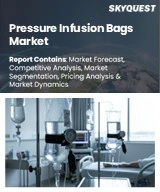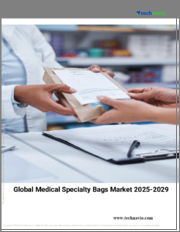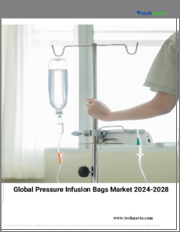
|
시장보고서
상품코드
1529860
의료용 특수 백 시장 규모, 점유율, 동향 분석 보고서 : 제품별, 지역별, 부문별 예측(2024-2030년)Medical Specialty Bags Market Size, Share & Trends Analysis Report By Product (Ostomy Collection Bags, Urinary Collection Bags, Blood Bags, Bile Collection Bags, Sterile Packaging Bags), Region, And Segment Forecasts, 2024 - 2030 |
||||||
의료용 특수 백 시장의 성장과 동향:
Grand View Research, Inc.의 최신 보고서에 따르면 의료용 특수 백 세계 시장 규모는 2030년에 140억 6,000만 달러로 추정되며, 2023년부터 2030년까지 연평균 4.4% 성장할 것으로 예상됩니다.
고령화 인구 비율의 증가와 요실금과 같은 질병의 유행은 향후 7년간 시장 성장을 촉진하는 주요 요인이 될 것으로 예상됩니다.
제품 제공의 비용 효율성을 개선하여 고객의 관심을 끌기 위한 정부 정책 및 이니셔티브는 예측 기간 동안 수요를 촉진할 것으로 예상됩니다. 제품의 매력을 높이기 위한 상환 정책의 합리화도 예측 기간 동안 의료용 특수 백 시장의 성장에 큰 역할을 할 것으로 예상됩니다.
가처분 소득의 증가와 다양한 질병에 대한 건강 인식의 증가, 미충족 의료 수요의 증가, 브라질, 중국, 인도와 같은 신흥국에서 저렴한 가격의 의료용 특수 백의 도입과 함께 업계의 미래 성장을 촉진할 것으로 예상됩니다. 미국과 캐나다의 높은 의료기기 관세율은 향후 7년간 의료용 특수 백 시장에 중요한 도전이 될 것으로 예상됩니다.
의료용 특수 백 시장은 제품 유형에 따라 크게 소변 채취 가방, 마취 호흡 가방, 무균 포장 가방, 혈액 가방, 담즙 채취 가방, 시체 가방, 장루 가방, 장내 영양 가방, 정맥 주입 가방, 지속적 외래 복막투석 가방으로 나뉩니다. (CAPD) 등이 있습니다.
의료용 특수 백 시장 보고서 하이라이트
- 장루 회수 백은 2013년에 가장 큰 제품 부문으로 2014년부터 2020년까지 연평균 4.3% 성장하여 29억 4,000만 달러에 달할 것으로 추정됩니다. 한편, 담즙 채취용 백은 최소침습적 복강경 담낭 절제술에 대한 수요가 증가함에 따라 2014년부터 2020년까지 CAGR 6.5%로 급성장할 것으로 예상됩니다.
- 수액백 시장의 매출은 2020년까지 24억 6,990만 달러에 달할 것으로 예상되며, 2014년부터 2020년까지 5.2%의 CAGR로 성장할 것으로 예상됩니다. 의료용 특수 백은 재택 의료 및 수술 센터와 같은 틈새 부문으로 구성되어 있으며, SurgiCenters와 같은 비 병원 소규모 업체는 수요 증가와 고객 인지도 증가로 인해 시장 성장을 주도했습니다. 이 가방은 병원에서 수술에 사용됩니다.
- 북미는 정교한 의료 인프라, 환자들의 인식 수준 향상, 그리고 상환 체계로 인해 2013년에 가장 큰 시장 점유율을 차지했습니다. 이러한 요소들은 이 지역의 높은 사용률과 수술 건수에 영향을 미쳤습니다.
- 아시아태평양의 의료용 특수 백 시장은 2014년부터 2020년까지 6.0% 이상의 CAGR로 가장 높은 성장률을 보일 것으로 예상됩니다. 의료 지식의 향상, 의료 인프라 및 의료 비용의 개선은 예측 기간 동안 급성장할 것으로 예상되는 몇 가지 요인 중 일부입니다.
목차
제1장 조사 방법과 범위
제2장 주요 요약
제3장 의료용 특수 백 시장 변수, 동향, 범위
- 시장 계통 전망
- 상부 시장 전망
- 관련/부수 시장 전망
- 시장 역학
- 시장 성장 촉진요인 분석
- 시장 성장 억제요인 분석
- 의료용 특수 백 시장 분석 툴
- 업계 분석 - Porter's Five Forces 분석
- PESTEL 분석
- 파이프라인 분석
제4장 의료용 특수 백 시장 : 치료별 추정·동향 분석
- 세계의 의료용 특수 백 시장 : 제품별 대시보드
- 세계의 의료용 특수 백 시장 : 제품별 변동 분석
- 세계의 의료용 특수 백 시장 : 제품별 매출
- 오스토미 채취 백
- 정맥내(IV) 수액백
- 지속 휴대형 복막투석(CAPD) 백
- 채뇨 백
- 멸균 포장 백
- 마취 호흡 백
- 시체봉투
- 혈액백
- 관장 백
- 경장영양 백
- 담즙 채취 백
- 얼음 주머니
제5장 의료용 특수 백 시장 : 지역별 추정·동향 분석
- 지역별 대시보드
- 시장 규모, 예측 동향 분석, 2018-2030년
- 북미
- 유럽
- 아시아태평양
- 라틴아메리카
- 중동 및 아프리카
제6장 경쟁 상황
- 기업/경쟁 분류
- 벤더 상황
- 주요 판매대리점 및 채널 파트너 리스트
- 주요 고객
- 주요 기업의 시장 점유율 분석, 2023년
- B. Braun SE
- Baxter
- Bard
- Coloplast A/S
- Convatec Inc.
- Fresenius Medical Care AG
- Hollister Incorporated
- SB-KAWASUMI LABORATORIES, INC.
- Macopharma
- Pall Corporation(Danaher)
- Terumo Corporation
- Westfield Medical Ltd.
Medical Specialty Bags Market Growth & Trends:
The global medical specialty bags market size was estimated at USD 14.06 billion in 2030 and is expected to grow at a CAGR of 4.4% from 2023 to 2030, according to a new report by Grand View Research, Inc. Growing percentage of aging population and prevailing diseases such as urinary incontinence is expected to be the key driving factor for market growth over the next seven years.
Government policies and initiatives intended to draw customer attention by improving the cost-effectiveness of product offering is expected to drive demand over the forecast period. Streamlined reimbursement policies to make the product more attractive is also expected to play a major role in the growth of the medical specialty bag market over the forecast period.
Rise in the disposable income and growing health awareness regarding various diseases coupled with increasing unmet medical needs and the introduction of affordable medical specialty bags in emerging economies such as Brazil, China, and India is anticipated to propel the future growth of the industry. High excise tax rates on healthcare devices in theU.S and Canada is expected to serve as a key challenge for the medical specialty bags market over the next seven years.
Based on the type of product, the medical specialty bag market is broadly classified into urinary collection bags, anesthesia breathing bags, sterile packaging bags, blood bags, bile collection bags, cadaver bags, ostomy bags, enteral feeding bags, intravenous fluid bags, and continuous ambulatory peritoneal dialysis bags. (CAPD).
Medical Specialty Bags Market Report Highlights:
- Ostomy collection bags was the largest product segment in 2013 and is estimated to grow at a CAGR of 4.3% from 2014 to 2020 to reach USD 2.94 billion. Bile collection bags, on the other hand, are expected to grow at a fast pace with a CAGR of 6.5% from 2014 to 2020, on account of the rising need for minimally invasive laparoscopic cholecystectomy procedures.
- Intravenous (IV) fluid bags market revenue is estimated to reach USD 2,469.9 million by 2020, growing at a CAGR of 5.2% from 2014 to 2020. Medical specialty bags comprise niche segments including home healthcare and SurgiCenters. Small non-hospital players such as SurgiCenters are expected to drive the market growth owing to increasing demand and customer awareness. These bags are used for surgeries in hospitals.
- North America accounted for the largest share of the market in 2013 owing to the existence of sophisticated healthcare infrastructure, better patient awareness levels, and reimbursement framework. These elements are responsible for high rates of usage and procedure volumes in the region.
- Asia Pacific medical specialty bags markets expected to grow at the highest CAGR of over 6.0% from 2014 to 2020. Improved medical knowledge, in addition to improving healthcare infrastructure and disbursements, are some of the factors expected to account for its rapid growth over the forecast period.
Table of Contents
Chapter 1. Methodology and Scope
- 1.1. Market Segmentation & Scope
- 1.2. Segment Definitions
- 1.2.1. Product
- 1.2.2. Regional scope
- 1.2.3. Estimates and forecasts timeline
- 1.3. Research Methodology
- 1.4. Information Procurement
- 1.4.1. Purchased database
- 1.4.2. GVR's internal database
- 1.4.3. Secondary sources
- 1.4.4. Primary research
- 1.4.5. Details of primary research
- 1.4.5.1. Data for primary interviews in North America
- 1.4.5.2. Data for primary interviews in Europe
- 1.4.5.3. Data for primary interviews in Asia Pacific
- 1.4.5.4. Data for primary interviews in Latin America
- 1.4.5.5. Data for Primary interviews in MEA
- 1.5. Information or Data Analysis
- 1.5.1. Data analysis models
- 1.6. Market Formulation & Validation
- 1.7. Model Details
- 1.7.1. Commodity flow analysis (Model 1)
- 1.7.2. Approach 1: Commodity flow approach
- 1.7.3. Volume price analysis (Model 2)
- 1.7.4. Approach 2: Volume price analysis
- 1.8. List of Secondary Sources
- 1.9. List of Primary Sources
- 1.10. Objectives
Chapter 2. Executive Summary
- 2.1. Market Outlook
- 2.2. Segment Outlook
- 2.2.1. Product outlook
- 2.2.2. Regional outlook
- 2.3. Competitive Insights
Chapter 3. Medical Specialty Bags Market Variables, Trends & Scope
- 3.1. Market Lineage Outlook
- 3.1.1. Parent market outlook
- 3.1.2. Related/ancillary market outlook
- 3.2. Market Dynamics
- 3.2.1. Market driver analysis
- 3.2.2. Market restraint analysis
- 3.3. Medical Specialty Bags Market Analysis Tools
- 3.3.1. Industry Analysis - Porter's
- 3.3.1.1. Supplier power
- 3.3.1.2. Buyer power
- 3.3.1.3. Substitution threat
- 3.3.1.4. Threat of new entrant
- 3.3.1.5. Competitive rivalry
- 3.3.2. PESTEL Analysis
- 3.3.2.1. Political landscape
- 3.3.2.2. Technological landscape
- 3.3.2.3. Economic landscape
- 3.3.3. Pipeline Analysis
- 3.3.1. Industry Analysis - Porter's
Chapter 4. Medical Specialty Bags Market: Treatment Estimates & Trend Analysis
- 4.1. Global Medical Specialty Bags Market: Product Dashboard
- 4.2. Global Medical Specialty Bags Market: Product Movement Analysis
- 4.3. Global Medical Specialty Bags Market by Product, Revenue
- 4.4. Ostomy Collection Bags
- 4.4.1. Ostomy Collection Bags market estimates and forecasts 2018 to 2030 (USD Million)
- 4.4.2. Single use
- 4.4.2.1. Single use market estimates and segment forecasts 2018 to 2030 (USD Million)
- 4.4.3. Multiple use
- 4.4.3.1. Multiple use market estimates and segment forecasts 2018 to 2030 (USD Million)
- 4.5. Intravenous (IV) Fluid Bags
- 4.5.1. Intravenous (IV) fluid bags market estimates and forecasts 2018 to 2030 (USD Million)
- 4.5.2. PVC
- 4.5.2.1. PVC market estimates and segment forecasts 2018 to 2030 (USD Million)
- 4.5.3. Non-PVC
- 4.5.3.1. Non-PVC market estimates and segment forecasts 2018 to 2030 (USD Million)
- 4.6. Continuous Ambulatory Peritoneal Dialysis (CAPD) Bags
- 4.6.1. Continuous ambulatory peritoneal dialysis (CAPD) Bags market estimates and forecasts 2018 to 2030 (USD Million)
- 4.6.2. Bags
- 4.6.2.1. Bags market estimates and segment forecasts 2018 to 2030 (USD Million)
- 4.6.3. Disposable
- 4.6.3.1. Disposable market estimates and segment forecasts 2018 to 2030 (USD Million)
- 4.6.4. Reusable
- 4.6.4.1. Reusable market estimates and segment forecasts 2018 to 2030 (USD Million)
- 4.7. Urinary Collection Bags
- 4.7.1. Urinary collection bags market estimates and forecasts 2018 to 2030 (USD Million)
- 4.8. Sterile Packaging Bags
- 4.8.1. Sterile packaging bags market estimates and forecasts 2018 to 2030 (USD Million)
- 4.9. Anesthesia Breathing Bags
- 4.9.1. Anesthesia breathing bags market estimates and forecasts 2018 to 2030 (USD Million)
- 4.10. Cadaver (Body) Bags
- 4.10.1. Cadaver (Body) bags market estimates and forecasts 2018 to 2030 (USD Million)
- 4.11. Blood Bags
- 4.11.1. Blood bags market estimates and forecasts 2018 to 2030 (USD Million)
- 4.12. Enema Bags
- 4.12.1. Enema bags market estimates and forecasts 2018 to 2030 (USD Million)
- 4.13. Enteral Feeding Bags
- 4.13.1. Enteral feeding bags market estimates and forecasts 2018 to 2030 (USD Million)
- 4.14. Bile Collection Bags
- 4.14.1. Bile collection bags market estimates and forecasts 2018 to 2030 (USD Million)
- 4.15. Ice Bags
- 4.15.1. Ice Bags market estimates and forecasts 2018 to 2030 (USD Million)
Chapter 5. Medical Specialty Bags Market: Regional Estimates & Trend Analysis by Product
- 5.1. Regional Dashboard
- 5.2. Market Size, & Forecasts Trend Analysis, 2018 to 2030:
- 5.3. North America
- 5.3.1. U.S.
- 5.3.1.1. Key country dynamics
- 5.3.1.2. Regulatory framework/ reimbursement structure
- 5.3.1.3. Competitive scenario
- 5.3.1.4. U.S. market estimates and forecasts 2018 to 2030 (USD Million)
- 5.3.2. Canada
- 5.3.2.1. Key country dynamics
- 5.3.2.2. Regulatory framework/ reimbursement structure
- 5.3.2.3. Competitive scenario
- 5.3.2.4. Canada market estimates and forecasts 2018 to 2030 (USD Million)
- 5.3.3. Mexico
- 5.3.3.1. Key country dynamics
- 5.3.3.2. Regulatory framework/ reimbursement structure
- 5.3.3.3. Competitive scenario
- 5.3.3.4. Mexico market estimates and forecasts 2018 to 2030 (USD Million)
- 5.3.1. U.S.
- 5.4. Europe
- 5.4.1. UK
- 5.4.1.1. Key country dynamics
- 5.4.1.2. Regulatory framework/ reimbursement structure
- 5.4.1.3. Competitive scenario
- 5.4.1.4. UK market estimates and forecasts 2018 to 2030 (USD Million)
- 5.4.2. Germany
- 5.4.2.1. Key country dynamics
- 5.4.2.2. Regulatory framework/ reimbursement structure
- 5.4.2.3. Competitive scenario
- 5.4.2.4. Germany market estimates and forecasts 2018 to 2030 (USD Million)
- 5.4.3. France
- 5.4.3.1. Key country dynamics
- 5.4.3.2. Regulatory framework/ reimbursement structure
- 5.4.3.3. Competitive scenario
- 5.4.3.4. France market estimates and forecasts 2018 to 2030 (USD Million)
- 5.4.4. Italy
- 5.4.4.1. Key country dynamics
- 5.4.4.2. Regulatory framework/ reimbursement structure
- 5.4.4.3. Competitive scenario
- 5.4.4.4. Italy market estimates and forecasts 2018 to 2030 (USD Million)
- 5.4.5. Spain
- 5.4.5.1. Key country dynamics
- 5.4.5.2. Regulatory framework/ reimbursement structure
- 5.4.5.3. Competitive scenario
- 5.4.5.4. Spain market estimates and forecasts 2018 to 2030 (USD Million)
- 5.4.6. Norway
- 5.4.6.1. Key country dynamics
- 5.4.6.2. Regulatory framework/ reimbursement structure
- 5.4.6.3. Competitive scenario
- 5.4.6.4. Norway market estimates and forecasts 2018 to 2030 (USD Million)
- 5.4.7. Sweden
- 5.4.7.1. Key country dynamics
- 5.4.7.2. Regulatory framework/ reimbursement structure
- 5.4.7.3. Competitive scenario
- 5.4.7.4. Sweden market estimates and forecasts 2018 to 2030 (USD Million)
- 5.4.8. Denmark
- 5.4.8.1. Key country dynamics
- 5.4.8.2. Regulatory framework/ reimbursement structure
- 5.4.8.3. Competitive scenario
- 5.4.8.4. Denmark market estimates and forecasts 2018 to 2030 (USD Million)
- 5.4.1. UK
- 5.5. Asia Pacific
- 5.5.1. Japan
- 5.5.1.1. Key country dynamics
- 5.5.1.2. Regulatory framework/ reimbursement structure
- 5.5.1.3. Competitive scenario
- 5.5.1.4. Japan market estimates and forecasts 2018 to 2030 (USD Million)
- 5.5.2. China
- 5.5.2.1. Key country dynamics
- 5.5.2.2. Regulatory framework/ reimbursement structure
- 5.5.2.3. Competitive scenario
- 5.5.2.4. China market estimates and forecasts 2018 to 2030 (USD Million)
- 5.5.3. India
- 5.5.3.1. Key country dynamics
- 5.5.3.2. Regulatory framework/ reimbursement structure
- 5.5.3.3. Competitive scenario
- 5.5.3.4. India market estimates and forecasts 2018 to 2030 (USD Million)
- 5.5.4. Australia
- 5.5.4.1. Key country dynamics
- 5.5.4.2. Regulatory framework/ reimbursement structure
- 5.5.4.3. Competitive scenario
- 5.5.4.4. Australia market estimates and forecasts 2018 to 2030 (USD Million)
- 5.5.5. South Korea
- 5.5.5.1. Key country dynamics
- 5.5.5.2. Regulatory framework/ reimbursement structure
- 5.5.5.3. Competitive scenario
- 5.5.5.4. South Korea market estimates and forecasts 2018 to 2030 (USD Million)
- 5.5.6. Thailand
- 5.5.6.1. Key country dynamics
- 5.5.6.2. Regulatory framework/ reimbursement structure
- 5.5.6.3. Competitive scenario
- 5.5.6.4. Thailand market estimates and forecasts 2018 to 2030 (USD Million)
- 5.5.1. Japan
- 5.6. Latin America
- 5.6.1. Brazil
- 5.6.1.1. Key country dynamics
- 5.6.1.2. Regulatory framework/ reimbursement structure
- 5.6.1.3. Competitive scenario
- 5.6.1.4. Brazil market estimates and forecasts 2018 to 2030 (USD Million)
- 5.6.2. Argentina
- 5.6.2.1. Key country dynamics
- 5.6.2.2. Regulatory framework/ reimbursement structure
- 5.6.2.3. Competitive scenario
- 5.6.2.4. Argentina market estimates and forecasts 2018 to 2030 (USD Million)
- 5.6.1. Brazil
- 5.7. MEA
- 5.7.1. South Africa
- 5.7.1.1. Key country dynamics
- 5.7.1.2. Regulatory framework/ reimbursement structure
- 5.7.1.3. Competitive scenario
- 5.7.1.4. South Africa market estimates and forecasts 2018 to 2030 (USD Million)
- 5.7.2. Saudi Arabia
- 5.7.2.1. Key country dynamics
- 5.7.2.2. Regulatory framework/ reimbursement structure
- 5.7.2.3. Competitive scenario
- 5.7.2.4. Saudi Arabia market estimates and forecasts 2018 to 2030 (USD Million)
- 5.7.3. UAE
- 5.7.3.1. Key country dynamics
- 5.7.3.2. Regulatory framework/ reimbursement structure
- 5.7.3.3. Competitive scenario
- 5.7.3.4. UAE market estimates and forecasts 2018 to 2030 (USD Million)
- 5.7.4. Kuwait
- 5.7.4.1. Key country dynamics
- 5.7.4.2. Regulatory framework/ reimbursement structure
- 5.7.4.3. Competitive scenario
- 5.7.4.4. Kuwait market estimates and forecasts 2018 to 2030 (USD Million)
- 5.7.1. South Africa
Chapter 6. Competitive Landscape
- 6.1. Company/Competition Categorization
- 6.2. Vendor Landscape
- 6.2.1. List of key distributors and channel partners
- 6.2.2. Key customers
- 6.2.3. Key company market share analysis, 2023
- 6.2.4. B. Braun SE
- 6.2.4.1. Company overview
- 6.2.4.2. Financial performance
- 6.2.4.3. Product benchmarking
- 6.2.4.4. Strategic initiatives
- 6.2.5. Baxter
- 6.2.5.1. Company overview
- 6.2.5.2. Financial performance
- 6.2.5.3. Product benchmarking
- 6.2.5.4. Strategic initiatives
- 6.2.6. Bard
- 6.2.6.1. Company overview
- 6.2.6.2. Financial performance
- 6.2.6.3. Product benchmarking
- 6.2.6.4. Strategic initiatives
- 6.2.7. Coloplast A/S
- 6.2.7.1. Company overview
- 6.2.7.2. Financial performance
- 6.2.7.3. Product benchmarking
- 6.2.7.4. Strategic initiatives
- 6.2.8. Convatec Inc.
- 6.2.8.1. Company overview
- 6.2.8.2. Financial performance
- 6.2.8.3. Product benchmarking
- 6.2.8.4. Strategic initiatives
- 6.2.9. Fresenius Medical Care AG
- 6.2.9.1. Company overview
- 6.2.9.2. Financial performance
- 6.2.9.3. Product benchmarking
- 6.2.9.4. Strategic initiatives
- 6.2.10. Hollister Incorporated
- 6.2.10.1. Company overview
- 6.2.10.2. Financial performance
- 6.2.10.3. Product benchmarking
- 6.2.10.4. Strategic initiatives
- 6.2.11. SB-KAWASUMI LABORATORIES, INC.
- 6.2.11.1. Company overview
- 6.2.11.2. Financial performance
- 6.2.11.3. Product benchmarking
- 6.2.11.4. Strategic initiatives
- 6.2.12. Macopharma
- 6.2.12.1. Company overview
- 6.2.12.2. Financial performance
- 6.2.12.3. Product benchmarking
- 6.2.12.4. Strategic initiatives
- 6.2.13. Pall Corporation (Danaher)
- 6.2.13.1. Company overview
- 6.2.13.2. Financial performance
- 6.2.13.3. Product benchmarking
- 6.2.13.4. Strategic initiatives
- 6.2.14. Terumo Corporation
- 6.2.14.1. Company overview
- 6.2.14.2. Financial performance
- 6.2.14.3. Product benchmarking
- 6.2.14.4. Strategic initiatives
- 6.2.15. Westfield Medical Ltd.
- 6.2.15.1. Company overview
- 6.2.15.2. Financial performance
- 6.2.15.3. Product benchmarking
- 6.2.15.4. Strategic initiatives
(주말 및 공휴일 제외)


















